You have probably come across the name of some types of air compressors such as “rotary” or “reciprocating”, if you ever had to purchase one for your needs. And you have probably wondered what their differences are and which is good for what. The confusion would probably worsen, if you dug a little deeper and came across all these other type of air compressors.
Well, the first best step to know which type of air compressors you want to buy is to get familiar with them a little better and see which type would better match your specific requirements. Luckily, we have all you need to know in this post. Besides that, since Linquip is committed to facilitate your decision process even further, it has provided here and here a handful of options for you of various types of air compressors.
Gas Compressors in the Refrigeration Thermodynamic Cycle
Before anything let us mention that air is not the only gas that the compressor designs mentioned here can handle. There are many other common applications that involve the same compressor designs, as mentioned later on in this post, for compressing gases other than air.
Despite the fact that it is a little “too scientific”,
knowing about the role of gas compressors in the thermodynamic cycle of refrigeration could be quite beneficial for a better insight into how important gas compressor is to a lot domestic to industrial applications. It could also help you make the proper decision for purchasing and even maintaining your compressor.
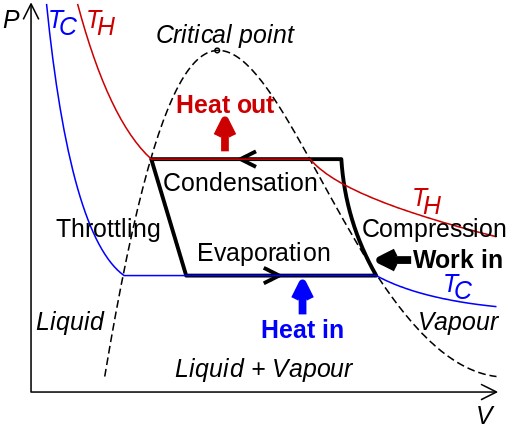
The cycle depicted above is a diagram in which you can see the thermodynamic cycle for the evaporation and then condensation of a refrigerant in a closed loop circuit. What happens during evaporation is heat absorption from the surrounding air. The evaporated refrigerant now needs to be returned to its liquid state to regain its power of heat absorption. This is where the gas compressor comes into play.
The pressure of the refrigerant is raised in the compressor to maybe even ten times its initial state in a process that also raises its temperature. It is now that the vapor can be liquefied in the condenser where it dissipates its heat to the environment at constant pressure. Since the pressure is still very high, it needs to be expanded in the expansion device, resulting in a low-temperature, low-pressure refrigerant. So, what any compressor does is basically increasing the pressure of some gas from low values to higher pressure values.
As can also be seen in the diagram, the pressure increase occurs during a reduction in volume. The reduction of volume could occur in the corresponding design configurations of positive displacement or dynamic types of air compressors, which will be discussed later in this post. Depending on the design of the compressor, and the requirements of the project, one could make use of a compressor with less footprint while still delivering the desired pressure increase.
What could also be seen in the diagram is the significant increase of the temperature during the compression process. This rise of gas temperature could also go above 100°C in some cases. Therefore, it is very important to consider the application for which the compressor will be used, so that there is no conflict between the compressor’s discharge temperature with the limits of the system.
It must be noted that for the same types of air compressors, the machine’s power consumption is reliant on the demanded pressure ratio. The pressure ratio of a compressor is the ratio of the compressed gas’ pressure to its initial state at the suction point of the compressor. It is natural to assume that higher pressure ratios demand for higher available power. Therefore, you also need to consider the cost and availability of power for your compressor’s power requirements when choosing one.
Types of Air Compressors
The types of air compressors discussed here are also seen when you need a compressor for another gas type, so if you see here, you’ll see it all about gas compressors!
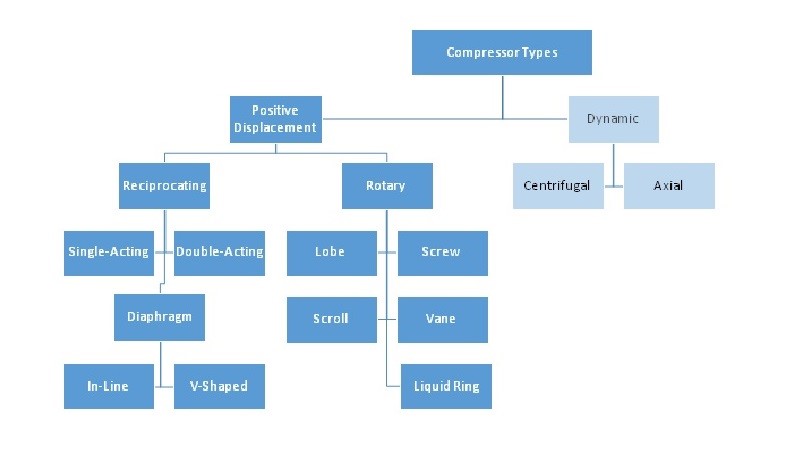
Let us start by stating that the major types of air compressors include two different ones: positive displacement and dynamic.
Compressor Types: Positive Displacement
For the case of positive displacement air compressors, the air is forced into a variable volume chamber, in which it undergoes an increase of pressure due to decreasing the volume of the chamber. This process is what we call “air compression”.
Upon reaching to some maximum pressure, the compressed air is ready to be discharged into the air compressor’s outlet. At this point, a valve opens to guide the compressed air out of the chamber.
Among different type of air compressors, the rotary air compressor or reciprocating air compressor, which you might have heard of, fall into this major category of positive displacement air compressors.
Rotary Compressors
There are five different types of rotary air compressors including screw, lobe, scroll, vane, and liquid ring types. Let us go through them one by one.
Rotary Screw Compressors
Rotary screw compressors are one of the types of air compressors that have two meshing helical screws with very little clearance between them, which push the air down a continuously shrinking space, hence raising its pressure during this compression process. There screws are turned in opposite directions by two shafts whose motion is adjusted by timing gears attached at the starting point of the shafts.
These types of compressors can be used for demands as low as 25 HP to as high as 600 HP delivered by some modern designs. Despite there are oil-free designs available, for most of the cases, it is oil that holds the responsibility of sealing, lubrication, and hear absorption from the oil-injected screw compressor. It must be noted, however, that the compressed air exiting the machine shall be oil free in order to be used in other components.
There is also this recently developed air screw compressors called the conical screw compressor. This type of air compressors is essentially a “conical spiral extension of a gerotor.” A gerotor can be seen below, which after being conically and spirally extended makes the conical screw compressor.
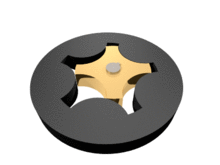
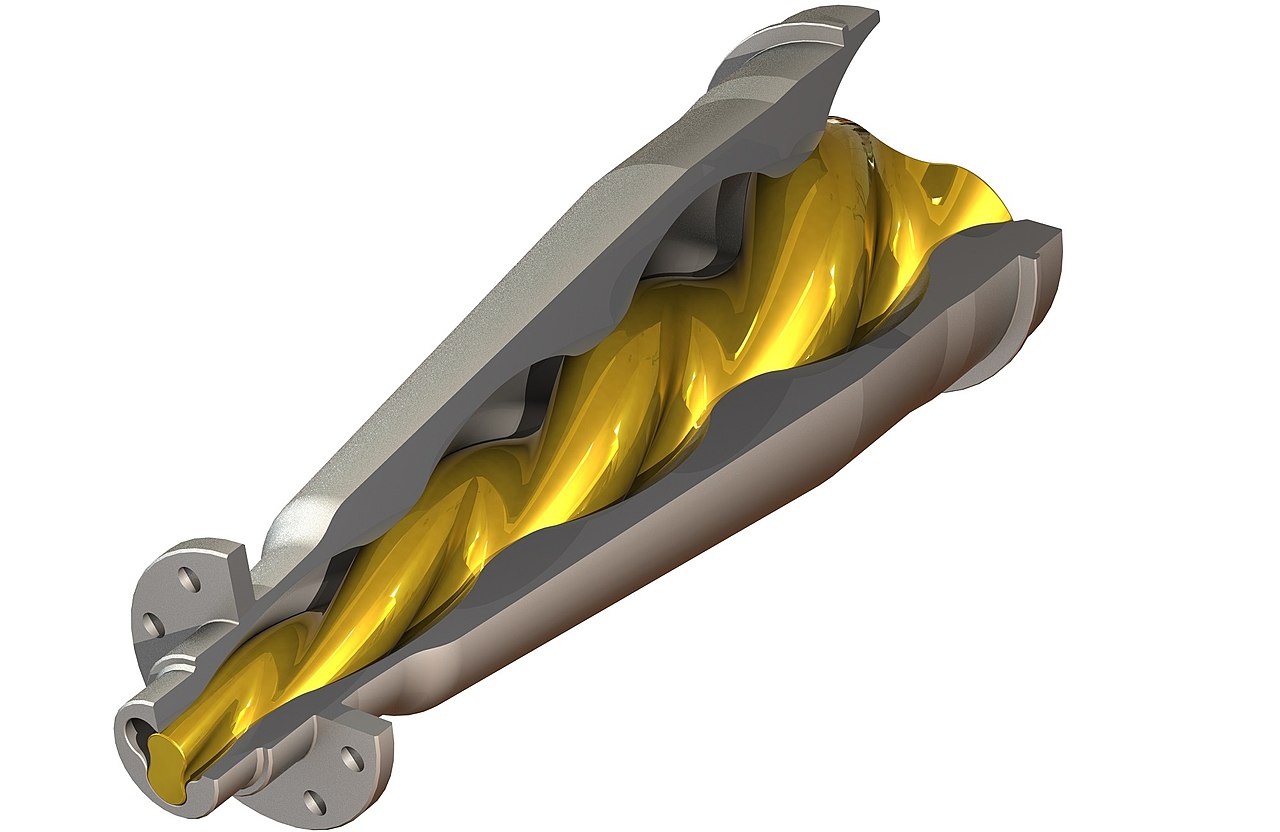
Advantages and Disadvantages of Rotary Screw Compressors
As for the advantages, when compared to other types of air compressors such as reciprocating ones which use pistons to compress the air, screw air compressors are less noisy due to continuous supply of compressed air. They are also more energy efficient and can supply high pressure ratios. You would also expect a lower temperature of the compressed air exiting the machine.
The disadvantages of screw compressors, on the other hand, include issues such as its price which is higher than the reciprocating compressors. Their design is also more complicated. From various types of air compressors, this type is one of those that requires close attention to its maintenance. For example, it must be used at least once in a week to avoid rusting.
Lobe Type Air Compressors
Lobe compressors are one of the types of air compressors which incorporate two intermeshing rotors rotated by two parallel shafts. Each of the two rotors will most likely have two lobes; nonetheless, tri-lobe rotor designs are also available.
When the air passes the inlet, it enters the displacement volume. It then is carries towards the outlet in a constant speed and constant displacement volume. The compression occurs when each rotor passes the machine’s outlet. Timing gears, same as for screw compressors, are responsible for controlling the relative position of the rotors to one another. The oil-free design could be possible if there is very small definite clearance between the rotors and the casing.
See here for a graphical representation of their operation.
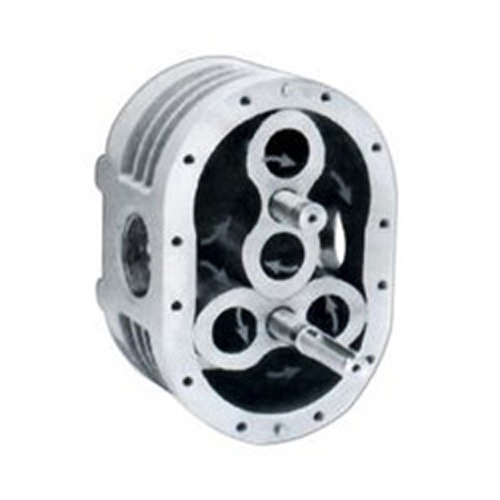
Advantages and Disadvantages of Lobe Type Air Compressors
Of the advantages of lobe compressors, one could consider their simpler design compared to screw compressors. Their power demand in partial loads is also lower. They also quickly reach to their full number of revolutions. They also operate efficiently at low RPMs.
For their disadvantages, the most important one is the wear on the air conveyor pipe, which leads to a higher chance of conveying material breakage.
Rotary Scroll Compressors
Rotary scroll compressors are one of the types of air compressors that are considered among the best rotary ones. There are two spiral elements inside these compressors, one of which is fixed and the other goes around in eccentric circles in the spiral.
The air is directed towards the center of the spiral, which compresses it due to a being transported inside a continuously shrinking volume. The air is then reached at its desired pressure after about two to three revolution of the rotor before it is discharged.
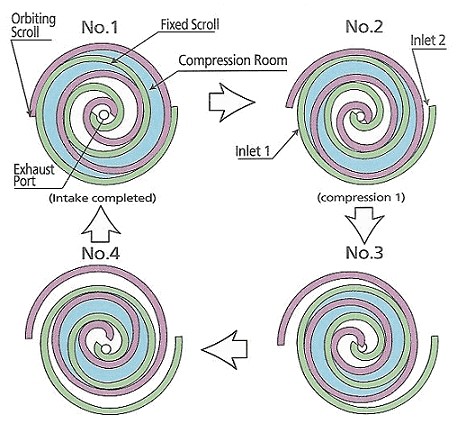
Advantages and Disadvantages of Rotary Scroll Compressors
One of the interesting advantages of rotary scroll compressors is that they are so quiet that one does not require any ear protection while being around them. They also have a very low footprint due to their compact design. In addition, they do not require many parts, so their design is relatively simple, as well as not requiring high maintenance.
The disadvantages; however, include their low output capacity, the need for an entirely new scroll element when the current one fails or is old, high temperature of the compressed air, and their relatively high price.
Rotary Vane Compressors
From various types of air compressors there is one that incorporates a rotary disk inside a cylindrical casing with slots that allow for sliding of the plates due to eccentric positioning of the rotor with respect to the casing. This type of compressors is called the rotary vane compressor.
As the disk rotates with rotation of the rotor, the plates slide correspondingly. Air gets trapped inside the compressors as the plates slide away from the center. Compression occurs when the plates move closer to each other.
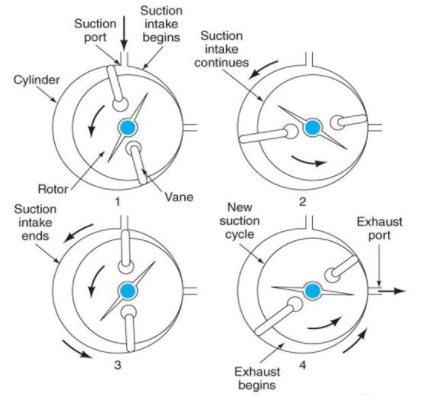
Advantages and Disadvantages of Rotary Vane Compressors
These types of air compressors do not cost much and are easy to maintain. Their design is also simple with low footprint (compact design). Therefore, these types are the best choice for low capacity applications such as air conditioners.
Liquid-Ring Compressors
Liquid-ring compressors are quite similar to rotary vane compressors, except that their vanes are integrated with the rotor. In these types of air compressors, sealing of the compression chamber occurs due to churning of a rotating liquid ring. As can be seen in the figure below, liquid-ring compressors would share a lot of mechanical characteristics with the rotary vane compressors.
What happens in these compressors is that some liquid such as water, which is the case for most applications, enters the compressor to form a ring on the inner surface of the cylindrical casing due a centrifugal force. Since the impeller’s axis of rotation and the casing’s geometric axis are eccentric, the enclosed volume between the impeller vanes and the casing changes intermittently.
As the air enters the chamber, it gets trapped between the volume enclosed by the impeller vanes and the liquid ring, and as the volume shrinks, it compresses the air. The compressed air then leaves the compressor at the discharge port.
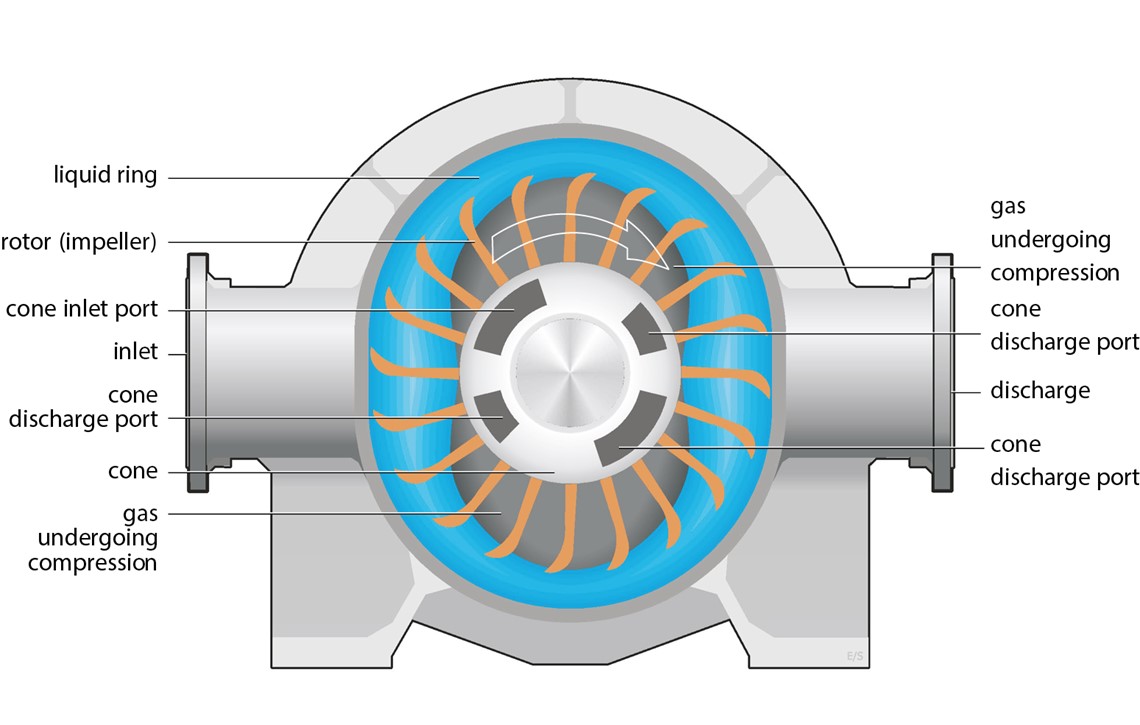
Advantages and Disadvantages of Liquid-Ring Compressors
The advantages of these types of air compressors include their fairly steady gas flow with very small pressure fluctuations, smooth running and low noise emission, good efficiency for both full-load and part-load operation, small footprint while still having relative high capacities, ability to use any sealant liquid making it the perfect choice for solvent recoveries and alike, and ideal for off gas and flare gas services. It could also easily handle wet process streams and fouling that would damage other mechanical compressors.
One of the advantages of these types of air compressors, however, is its potential bearing failure. In addition, it needs to be properly designed; otherwise, over-compression or under-compression would be expected situations. Due to its level of internal gas leakage, the discharge gas temperature is expected to be high. There is also considerable impeller and cylindrical casing wear for these types of air compressors.
Reciprocating compressors
Reciprocating compressors are one of the types of air compressors, in which a piston goes down and up a cylindrical volume to suck the air inside the chamber and compress it.
Reciprocating compressors can be of the single-acting or double-acting type. In single-acting reciprocating compressors, the piston compresses the air only on one side of it, while in double-acting reciprocating compressors the piston would compress the air on both of its sides. This design allows for higher horsepower sizes of as high as 1000 HP in the double-acting design.
Despite being more powerful, these designs are rarely used due to their complexity of manufacturing and requirement for frequent maintenance.
Single Acting Compressor
For the single-acting design, the suction valve opens while the piston passes some point in its volume expanding motion sucking in the air inside the compression chamber. After reaching the bottom dead center of the piston movement, the air gets compressed during the chamber volume shrinkage before it leaves the chamber through the open discharge valve.
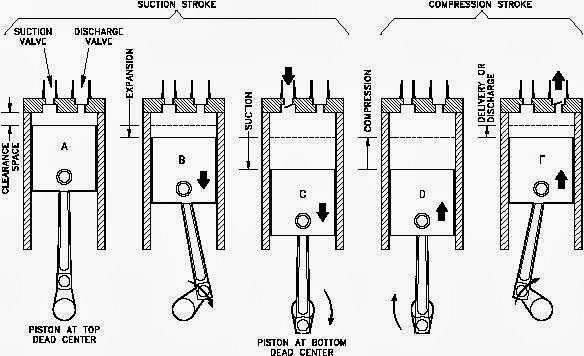
Double Acting Compressor
In the double acting design, there are two sets of suction and discharge valves on both sides of the piston. The movement of the system in one direction is the expansion/suction stroke for one side of the piston, while being the compression stroke for the other. In other words, both sides of the piston are used for continuously compressing the air.
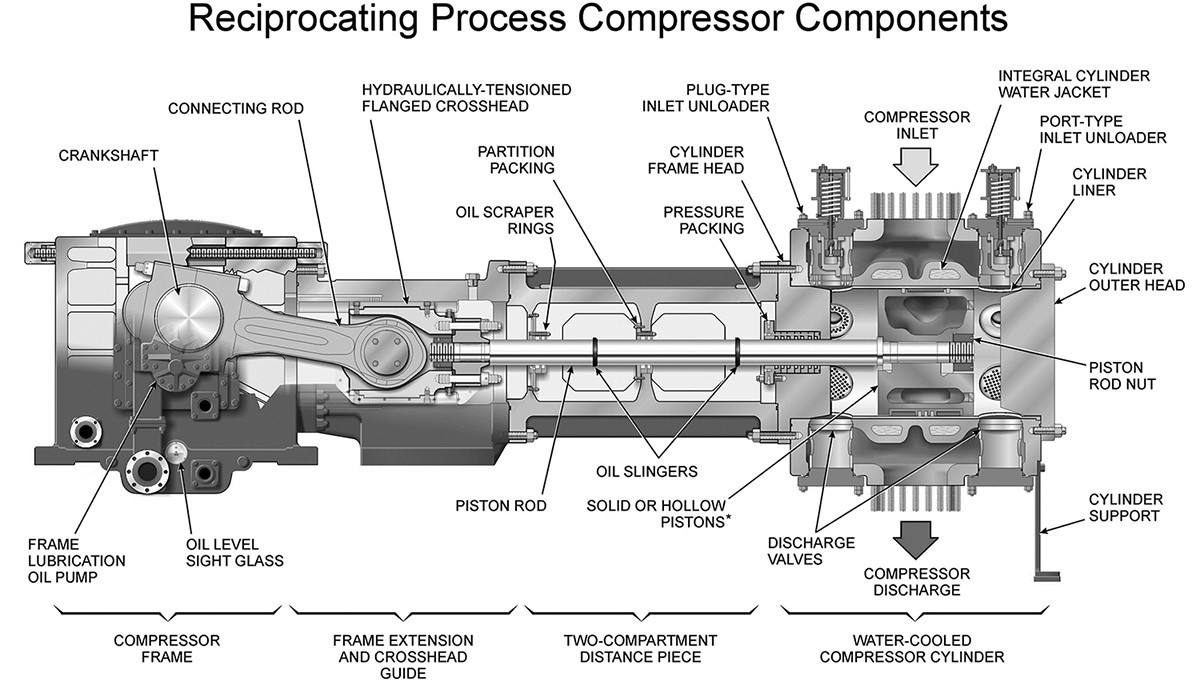
Advantages and Disadvantages
Single acting reciprocating compressors are relatively low in price and easy to maintain. These types of air compressors (reciprocating compressors) are very suitable for applications where there is need for high pressure but there is low or discontinuous flow. The double-acting design can provide continuous supply of compressed air as well as high horsepower ratings.
Their disadvantages, on the other hand, include their very intense noise emission, high temperature discharged air, and he fact their supplied air is not clean of oil content. As was already mentioned, the double-acting is not easy to manufacture and maintain, and the single-acting design is not so powerful.
Diaphragm
There is also another design of reciprocating compressors called diaphragm. In the diaphragm design of reciprocating compressors, there are flexible membranes instead of pistons for trapping the air or letting it pass through. This design is the best choice for handling toxic or explosive gases. These types of air compressors come in two forms of in-line and V-shaped designs.
In-Line Compressors
In the in-line design, he cylinders of various stages are placed in a straight line when viewed from the top. Their design is simple and can be driven by common electric motors or diesel engines. They could be used for applications requiring varying pressure.
V-Shaped Compressors
In this design, the crank shaft pulls down the piston on one of the cylinders while pushing up the piston to its perpendicular cylinder. The balancing on this design and the achieved torque is better for this design.
Compressor Types: Dynamic Compressors
Axial and centrifugal compressors, which you might have heard of, belong to one of the types of air compressors called the dynamic compressor. These machines increase the air pressure by passing it through rotating impellers. Such compressors are suitable for applications where there is need for completely oil-free air delivery
Axial compressors
Axial compressors are essentially used for power generation in industrial plants, land or marine power stations, and of course aircraft engines. In this design, the air is accelerated in the rotor blades and then decelerated through the stator vanes. These compressors usually have more than one stage (a set of rotor and stator is called a stage) to take the pressure to its intended value.
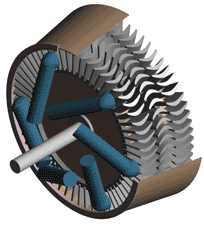
Centrifugal compressors
One of the important types of air compressors is the centrifugal type, which is widely used in industrial applications. In this design, the air enters through the compressor’s input into the impeller, by which it is accelerated. After reaching to the diffuser section of the compressor, the air in decelerated leading to an increase of pressure; air compression. This compressed air is then received by the collector.
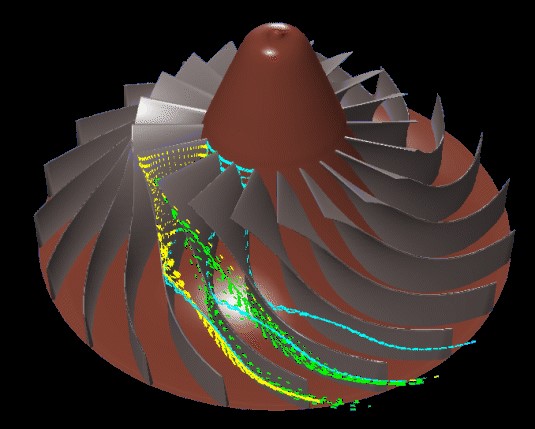
Since these compressors can be made in multi-stage configurations, they are more efficient than the rotary screw compressors which are categorized under the positive displacement types of air compressors.
These compressors are widely used in oil and gas industries as well as in turbochargers. They are best used for applications requiring 250HP and above, and can go for as high as 6K HP for specific applications.
Advantages and Disadvantages
The advantages of these types of air compressors are many. Maybe the most important advantage of centrifugal compressors is the fact that they can supply oil-free air. This means that they can be used for sensitive applications that demand high quality air (or other compressed gases), and filters at the compressor discharge are absent. Centrifugal compressors in addition do not require much of maintenance and can be run nonstop for years.
The disadvantages include large frontal area for the same air flow compared to the axial design, sensitivity to changes in the gas composition, necessity for advanced vibration control due to their high rotational speed, limited pressure ratios, and the possibility of compressor choke and surge.
Applications of Air Compressors
The applications of air compressors go as far as the need for compressed air goes. We have already heard about their use in air conditioning and refrigerating systems, as well as utility systems such as power generation and chemical processes. Now, let us turn our attention to some other applications that might not readily come to mind. If we categorize air compressors into the three grades of domestic, commercial, and industrial, we can mention some of those other air compressor applications in a rather organized manner.
- Domestic grade air compressors can be used in pneumatic tools used in home projects, painting tools that spray paint on surfaces, cleaning tight spaces with pressurized air, etc.
- Commercial grade air compressors can be used again in pneumatic tools such as nail guns and spray painting devices in auto body shops, pneumatic drills and hammers in construction sites, blowguns, sandblasting tools, etc.
- Industrial grade air compressors can be used in multiple industries such as:
- manufacturing: operating air tools on production lines, welding, cutting, vessel and tube purging, finishing and packaging
- agriculture: ventilation systems, spraying crops, pneumatic equipment for handling various material, etc.
- pharmaceuticals: material handling equipment, spraying equipment, pressurizing vessels and tanks, packaging, etc.
- and so many more!
Compressors Used for HVAC
The reciprocating air compressor is the most widely used type of compressors used in air conditioning systems. Multiple cylinders, in which the compression magic happens, can be included in one unit, which means that AC systems using reciprocating air compressors are quite flexible when in terms of their provided pressure ratios.
Scroll compressors, which are relatively new in the world of AC compressors, are gaining a momentum in the HVAC compressor industry as they have very few moving parts compared to the reciprocating compressor types. They are also efficient and reliable, all of which making them an interesting choice for the compressor of air conditioning systems.
Well, when it comes to efficiency and reliability, it is very difficult to beat screw compressors. It is interesting that these types of air compressors are also present in the HVAC industry; however, they are used in larger-scale AC systems such as for the central units in large building where an enormous amount of air is demanded from the air conditioning system.
Now, if you have a very large building with a complex air conditioning plan, you might want to consider centrifugal air compressors that are usually specifically reserved for those kinds of applications.
There are also rotary-vane air compressors used for air conditioning systems where there is a requirement for silent operation as well as space limitations. These types of air compressors produce a very lower amount of noise compared to other types of air compressors and leave a modest footprint making them the perfect choice for such applications.
Read More In Linquip
- Difference Between Air Compressor and Air Pump
- What is a Compressor Used For?
- Types of Centrifugal Compressor: An Ultimate Guide
- How an Air Conditioners Compressor Work?
- 3 phase air compressor: what is it and how to wire it
- Everything You Need To Know About Different Types Of Compressor
- Axial Flow Compressors101: The Essential Overview
- Rotary Vane Compressors 101: The Essential Intro
- How Much Does It Cost to Replace A Compressor in An Air Conditioner?

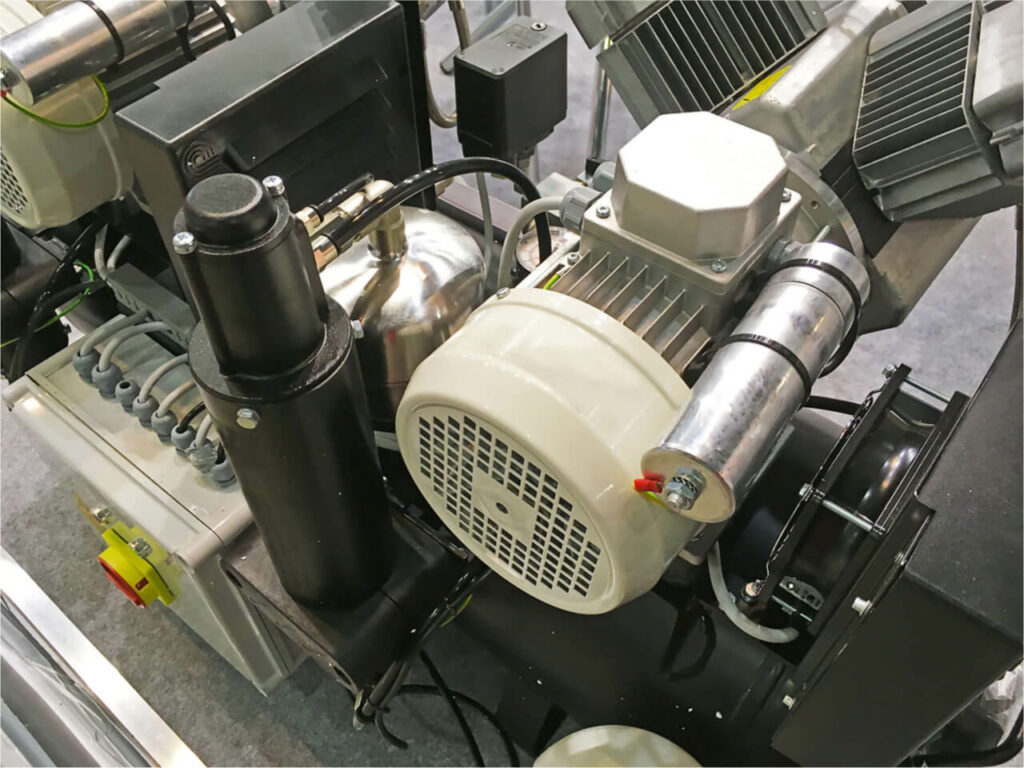

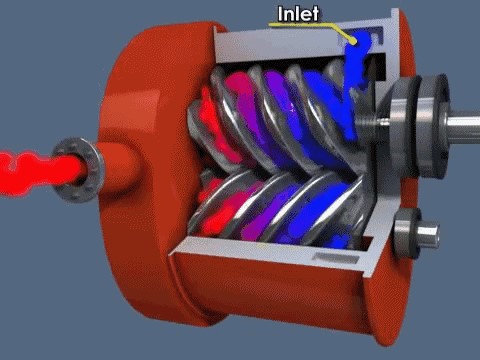
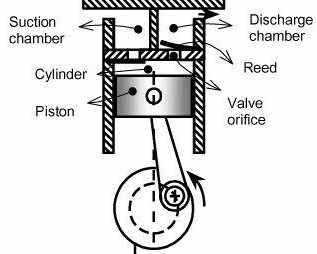
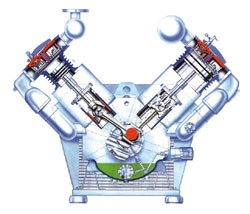


The grammar here is atrocious.